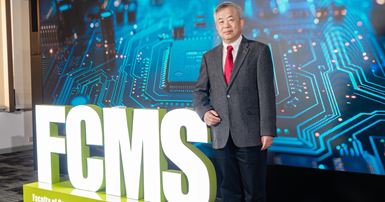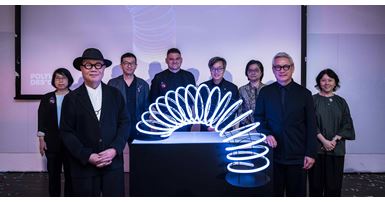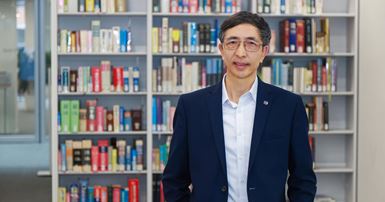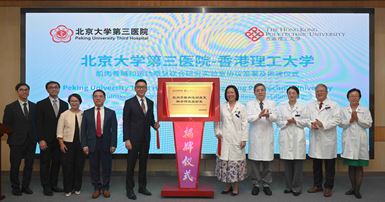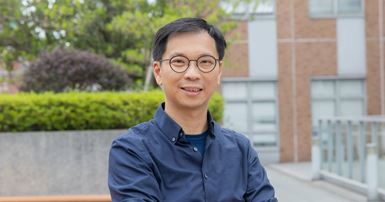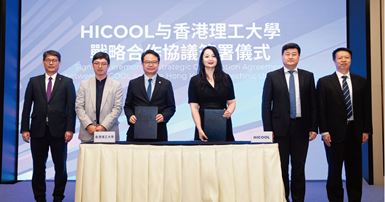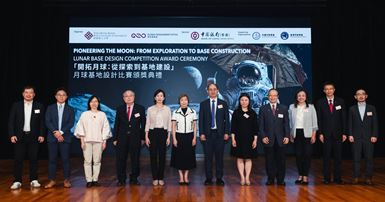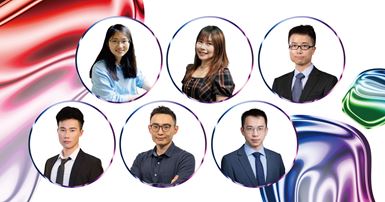PolyU startups showcase innovation and entrepreneurial achievements at London Tech Week 2025
The Hong Kong Polytechnic University (PolyU) took part in the world-renowned London Tech Week 2025 held from 9 to 11 June in London, UK, as the only participating university from Hong Kong. Four PolyU startups showcased their ground-breaking innovations in artificial intelligence (AI), advanced manufacturing technologies and healthcare solutions. The event attracted business leaders, industry experts and investors from around the world, providing the PolyU startups with valuable opportunities to explore potential collaborations and establish partnerships.
PolyU is committed to translating cutting-edge research into impactful solutions that address real-world challenges. Below are introductions to the four PolyU startups.
PolyU Startup
Founder(s)
Introduction
Advantage Data Vision Limited
Prof. Lawrence Wing Chi CHAN
Associate Professor, Department of Health Technology and Informatics; and Director, Advantage Data Vision Limited
The startup has leveraged massive real‑world, multi‑omics datasets and patented AI algorithms to create a cloud‑based platform that accurately predicts patients’ response to cancer immunotherapy. The deep‑learning engine guides clinicians, optimises hospital resources, reduces adverse events and accelerates pharmaceutical trials through precise patient stratification and risk assessment, delivering tangible value worldwide.
Light-weight Technologies Limited
Prof. Jianguo LIN
Chair Professor of Materials Technologies, Department of Industrial and Systems Engineering; and Co-founder and Chairman, Light-weight Technologies Limited
Dr Qingsong WENG
Research Associate, Department of Industrial and Systems Engineering; and Co-founder and Chief Executive Officer, Light-weight Technologies Limited
The startup uses their globally unique light alloy manufacturing technologies, such as advanced hot stamping and extrusion techniques, with its self-developed smart industrial software and advanced simulation platform to produce ultra-thin, ultra-wide light alloy profiles and complex curved profiles that are unattainable with existing manufacturing processes. The startup provides high-strength, lightweight, cost-effective, and sustainable solutions that enable energy saving and emission reduction for the automotive, aerospace, railway, marine, and other engineering sectors, gaining wide recognition from leading global OEMs.
UbiquiTech Innovations Limited
Prof. Jiannong CAO
Dean, Graduate School; Otto Poon Charitable Foundation Professor in Data Science; Chair Professor of Distributed and Mobile Computing; Director, Research Institute for Artificial Intelligence of Things; Director, University Research Facility in Big Data Analytics; and Co-founder and Chief Scientist, UbiquiTech Innovations Limited
Dr Zhixuan LIANG
PolyU GBA Postdoctoral Fellow; and Chief Executive Officer, UbiquiTech Innovations Limited
The startup is committed to the intersection of robotics, AI and smart city solutions, with a view to developing cutting-edge autonomous robots designed to address complex challenges in modern urban and industrial environments.
viAct
Mr Gary Chun-kui NG
Co-founder and Chief Executive Officer, viAct
Mr Hugo CHEUK
Co-founder and Chief Operating Officer, viAct
viAct is a pioneer in AI monitoring technology dedicated to enhancing safety and efficiency in heavy industries such as construction, oil and gas, and manufacturing. The startup made it onto Forbes Asia 100 to Watch list in 2022. Its leading, globally deployed technology “Scenario-based Vision Intelligence”, was showcased at renowned international events such as the World Economic Forum.
At the event’s panel discussion themed “Creating the Future from Campus: Why are University Spinouts so Important for Innovation?”, Prof. Christopher CHAO, PolyU Vice President (Research and Innovation), shared his insights into knowledge transfer, the nurturing of university spinouts, and the support and resources available to PolyU startups. Prof. Chao remarked, “Supported by PolyU’s signature startup ecosystem, PolyVentures, our startups are spearheading translational innovations that generate long-lasting global societal impact. Our ecosystem not only provides invaluable development opportunities but also fosters the international growth of our entrepreneurs. I am delighted to see PolyU startups shine at London Tech Week, inspiring global audiences with their creativity and determination to make a difference.”
This year, the London Tech Week attracted over 45,000 participants from more than 90 countries, including startups, technology giants, investors and innovators. The event provided a platform for startups to engage in person with venture capitalists, corporate investors and angel investors; promote their solutions on dedicated stages; connect with industry leaders at the forefront of innovation; and gain valuable insights from successful entrepreneurs who have expanded globally. For more information, please visit the event website.
Advantage Data Vision Limited, a PolyU startup, has leveraged massive real‑world, multi‑omics datasets and patented AI algorithms to create a cloud‑based platform that accurately predicts patients’ response to cancer immunotherapy.
Light-weight Technologies Limited, a PolyU startup, uses its globally unique light alloy manufacturing technologies with its self-developed smart industrial software and advanced simulation platform to produce ultra-thin, ultra-wide light alloy profiles and complex curved profiles that are unattainable with existing manufacturing processes.
UbiquiTech Innovations Limited, a PolyU startup, is committed to the intersection of robotics, AI and smart city solutions, with a view to developing cutting-edge autonomous robots designed to address complex challenges in modern urban and industrial environments.
viAct, a PolyU startup, is dedicated to enhancing safety and efficiency in heavy industries such as construction, oil and gas, and manufacturing through its pioneering AI monitoring technology.
***END***
Events
Knowledge Transfer and Entrepreneurship Office


